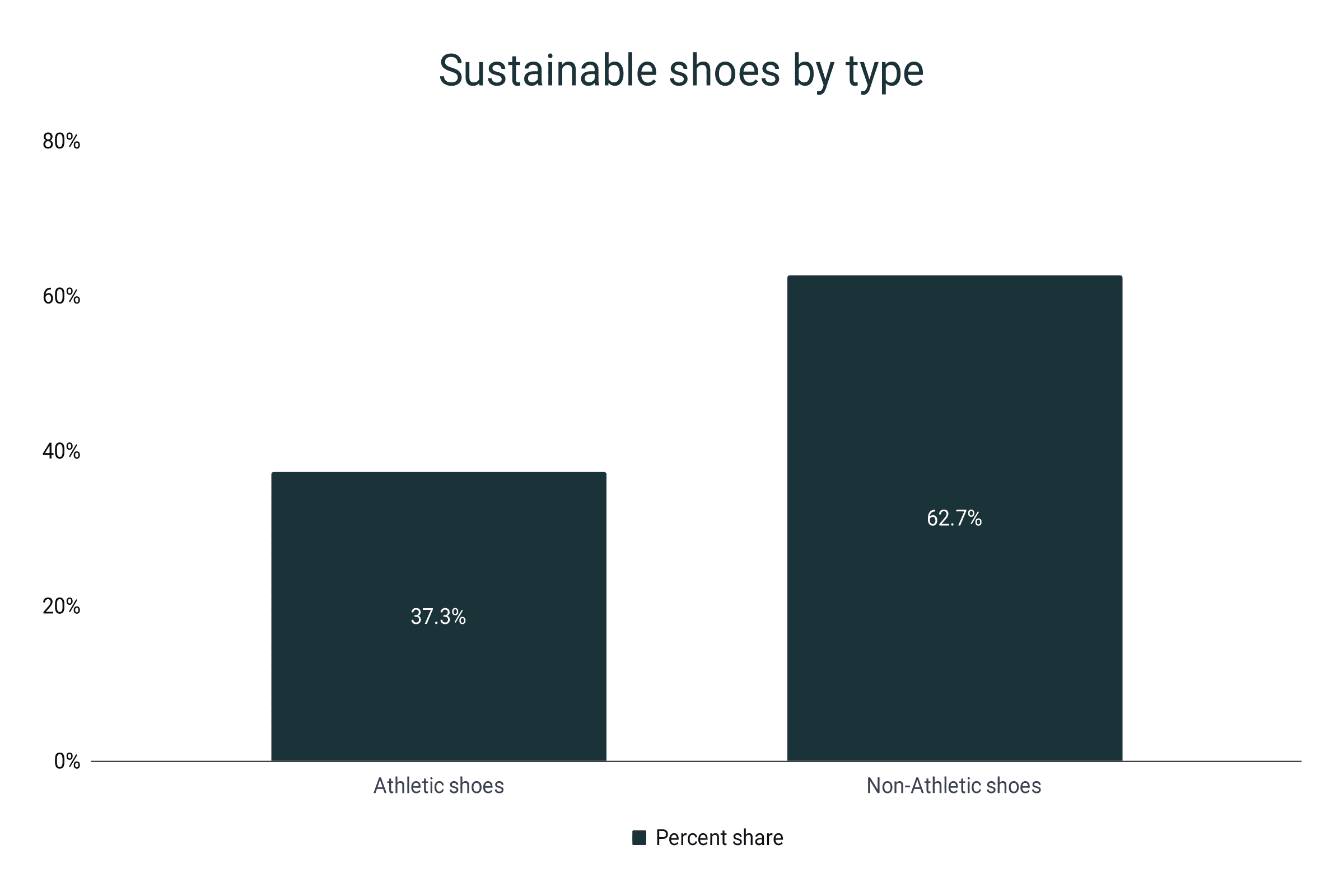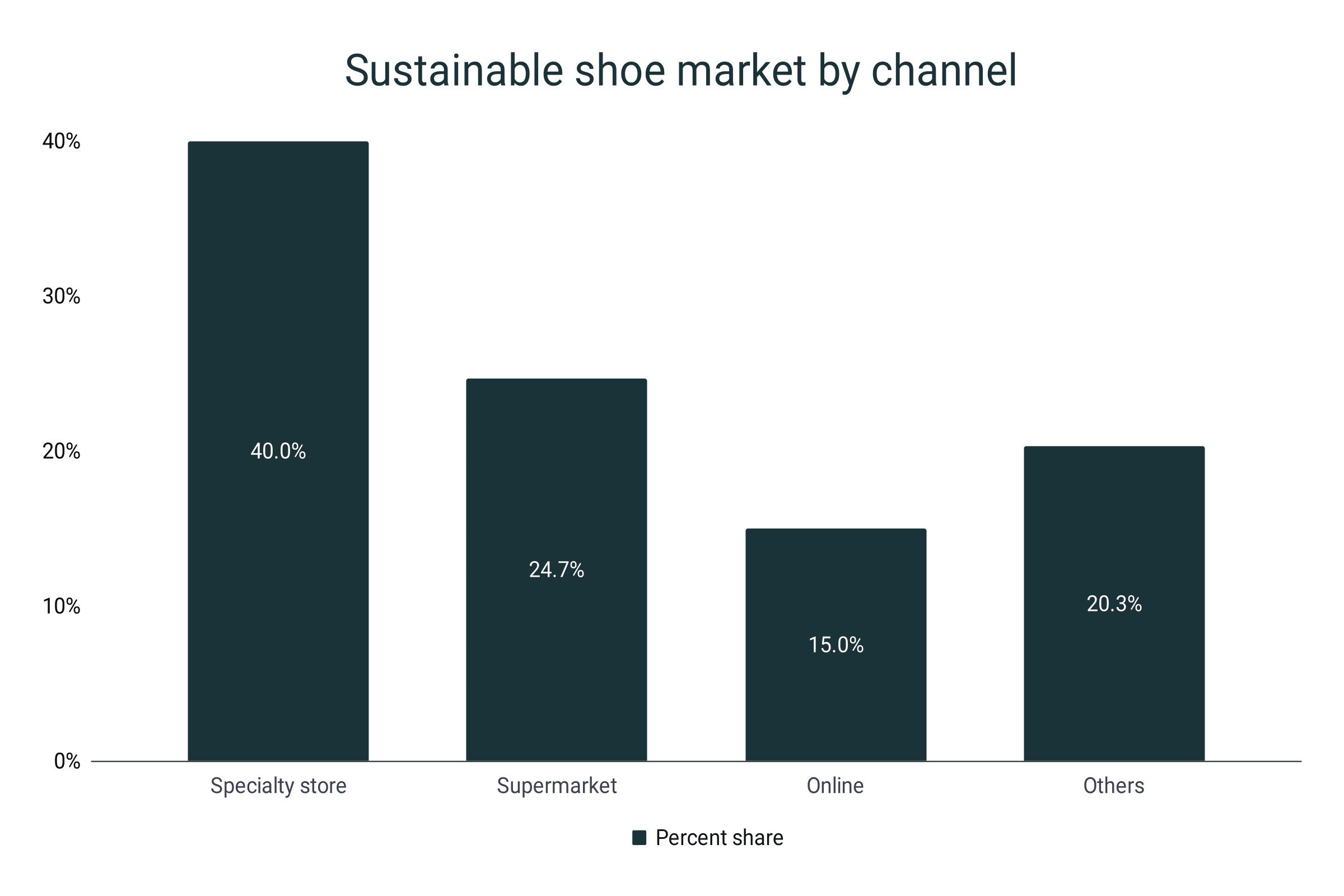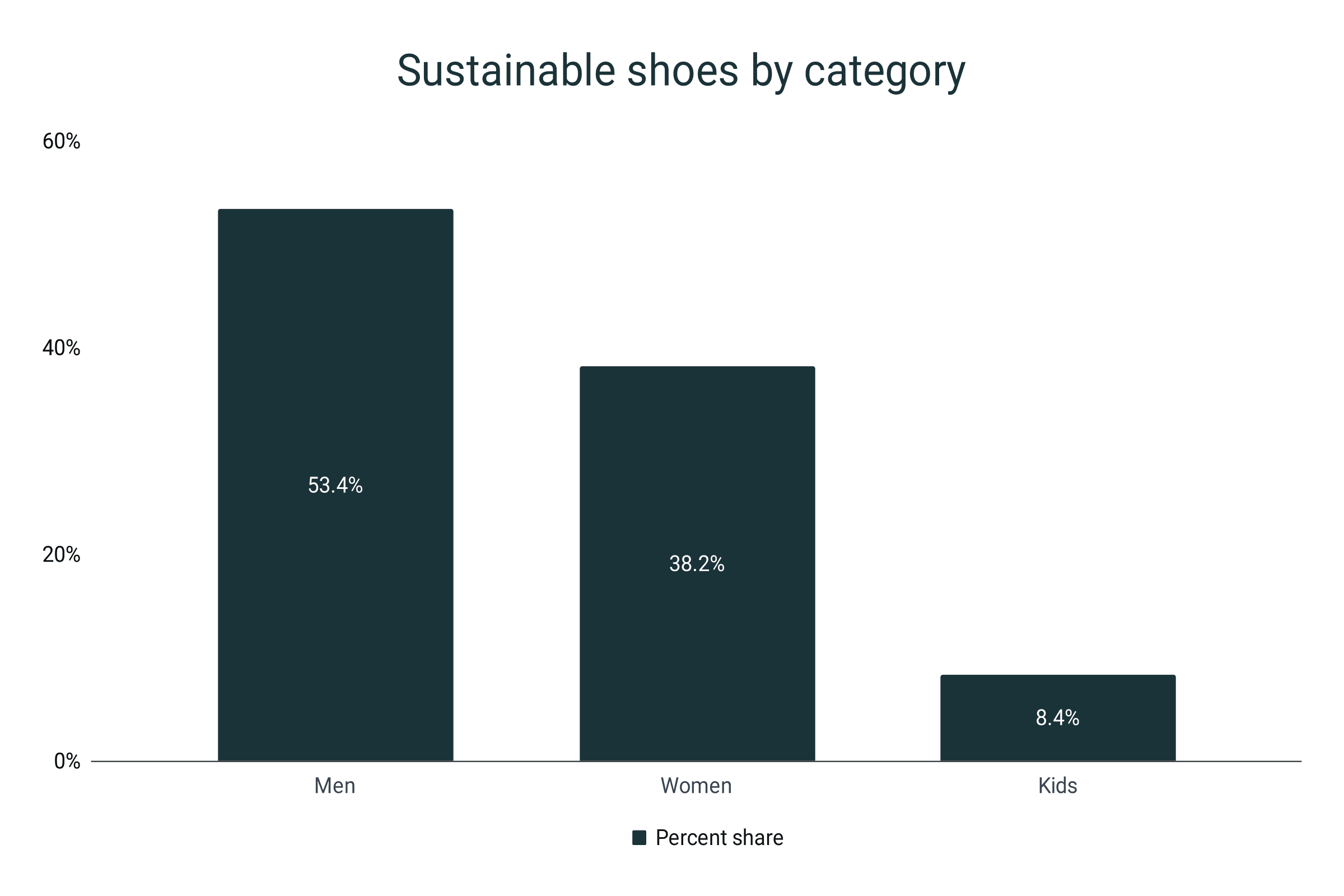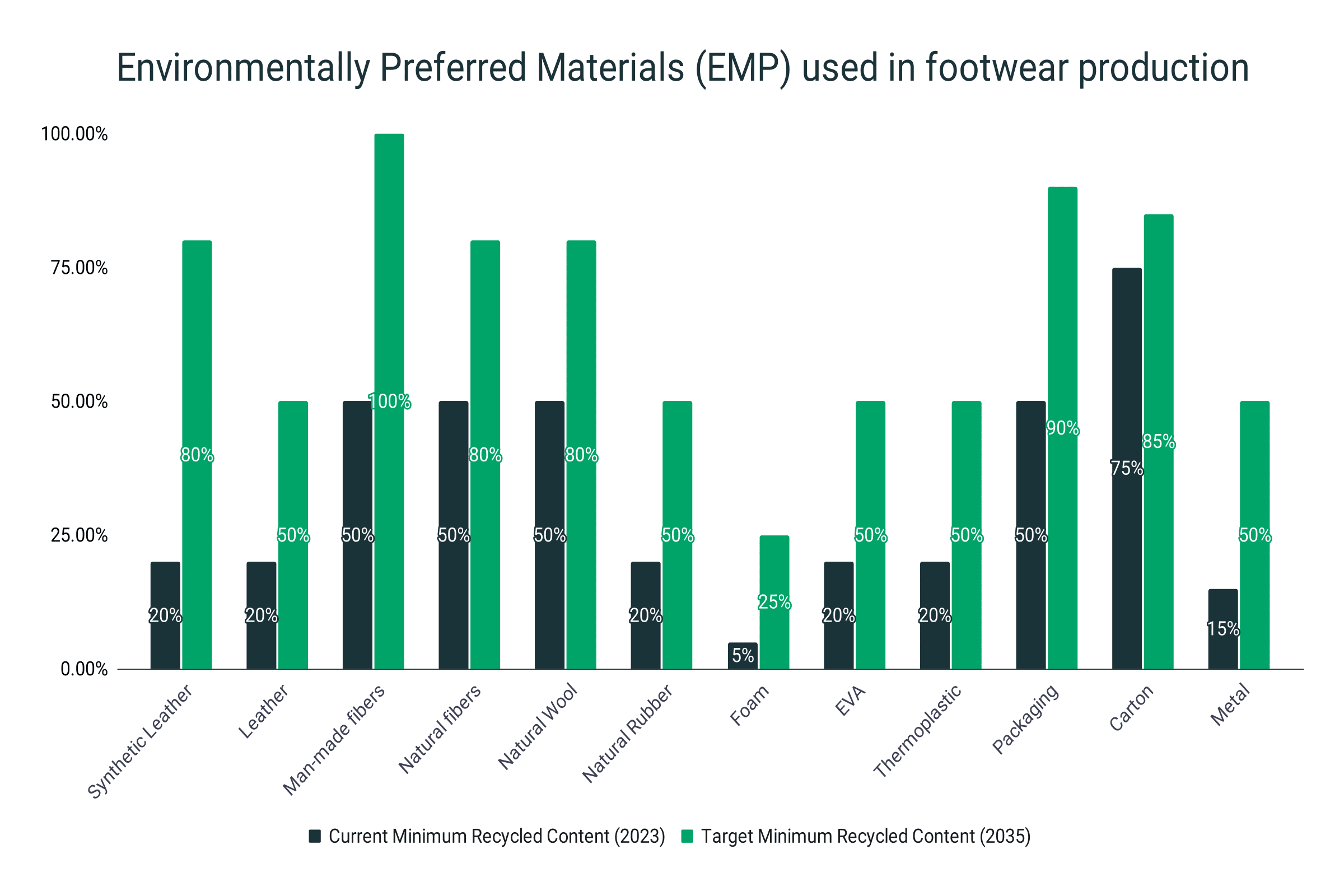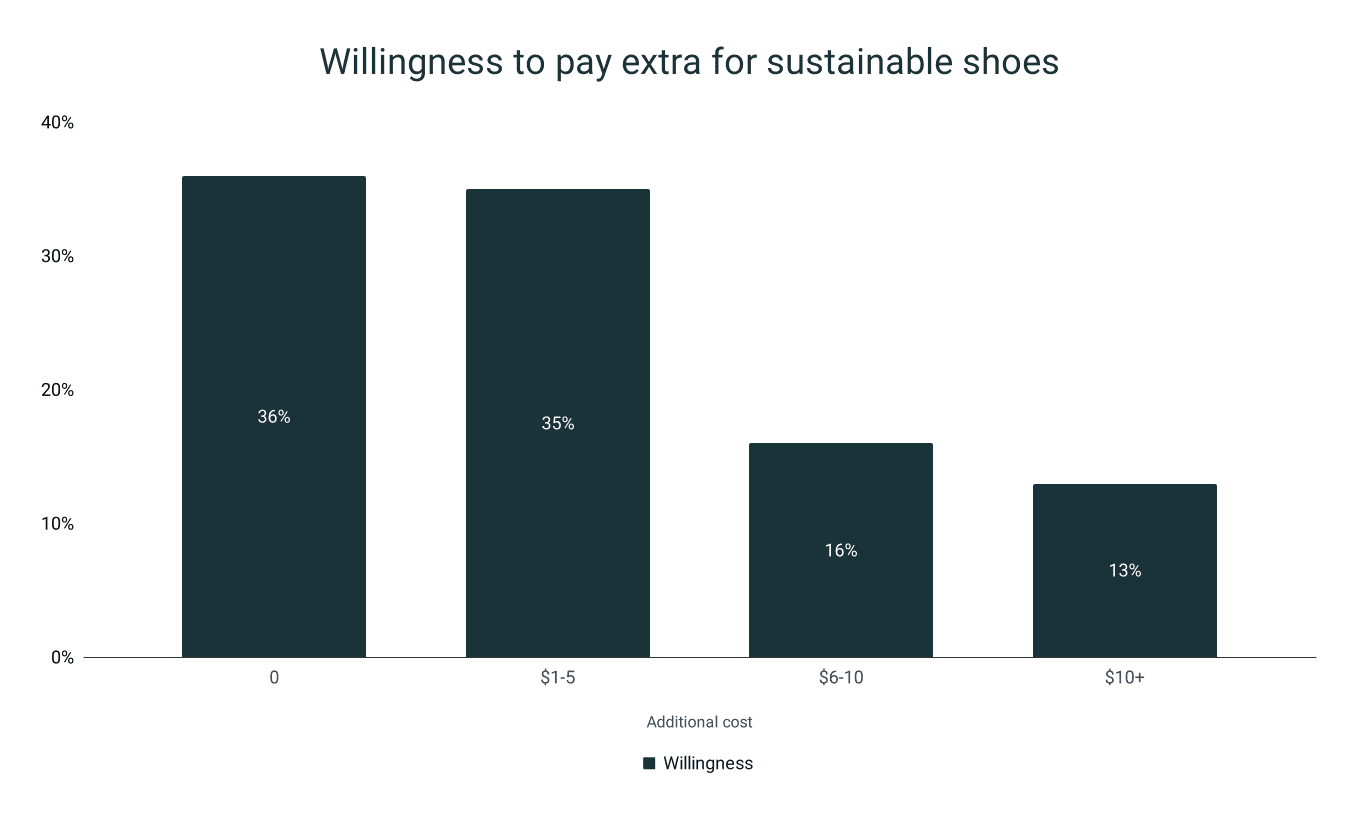Sustainable Shoes Statistics
This is a comprehensive report with 40+ facts and figures about the growing sustainable footwear industry. The term “sustainable shoe” in today’s context, means that a product contains a percentage of material that is recycled, repurposed, or organically sourced. Also, the manufacturing practices contribute to gauging how sustainable a shoe is.
Top sustainable shoe statistics
- The sustainable footwear industry is projected to grow 6.8%, reaching $9.4 billion in 2023.
- By 2030, the sustainable shoe revenue is expected to reach $13.3 billion.
- Around 62.7% of all sustainable footwear products are non-athletic.
- 40% of all footwear tagged as sustainable was bought through specialty stores.
- Men’s shoes comprise 53.4% of all sustainable shoes manufactured. Women’s shoes account for 38.2% while the remaining 8.4% is for kids' shoes.
- 73% of GenZs are willing to buy sustainable shoe products. Meanwhile, only 42% of Baby Boomers are considering buying sustainable shoes.
- 330 million pairs of sustainable footwear are manufactured annually.
- The Footwear Distributors and Retailers of America (FEDRA), which is composed of 700 members, requires 20% minimum recycled content on leather and natural rubber on shoes.
- 64% of the American consumer population is willing to pay extra for sustainable shoes. Of this figure, 35% say a $1-5 premium is ideal.
Sustainable shoe revenue by year
- By the end of 2023, the sustainable shoe market will have a total revenue of $9.4 billion.
- This is 6.8% better than the $8.8 billion figure in 2022.
- In 2021, the total revenue from sustainable shoes amounted to $8.1 billion.
- Compared to the $7.7 billion figure in 2020, the revenue of sustainable footwear has experienced a 5.2% year-on-year growth.
- Back in 2018, the sustainable footwear segment tallied $7.1 billion in revenue.
- Overall, from 2018 to 2021, the sustainable shoe segment has grown by 14.1%.
- By 2028, estimates say that the revenue from sustainable footwear will reach $12 billion, with a compound annual growth rate (CAGR) of 6.1% from 2021 to 2028.
- Furthermore, it is predicted to generate $13.3 billion by 2030, following a CAGR of 5.7% from 2021 to 2030.
Sustainable shoe revenue by year
|
Year |
Revenue in billion $ |
Growth |
|
2018 |
7.1 |
|
|
2019 |
7.5 |
5.6% |
|
2020 |
7.7 |
2.7% |
|
2021 |
8.1 |
5.2% |
|
2022 |
8.8 |
8.6% |
|
2023 |
9.4 |
6.8% |
|
2028* |
12.0 |
48.1% |
|
2030* |
13.3 |
10.8% |
*Projection
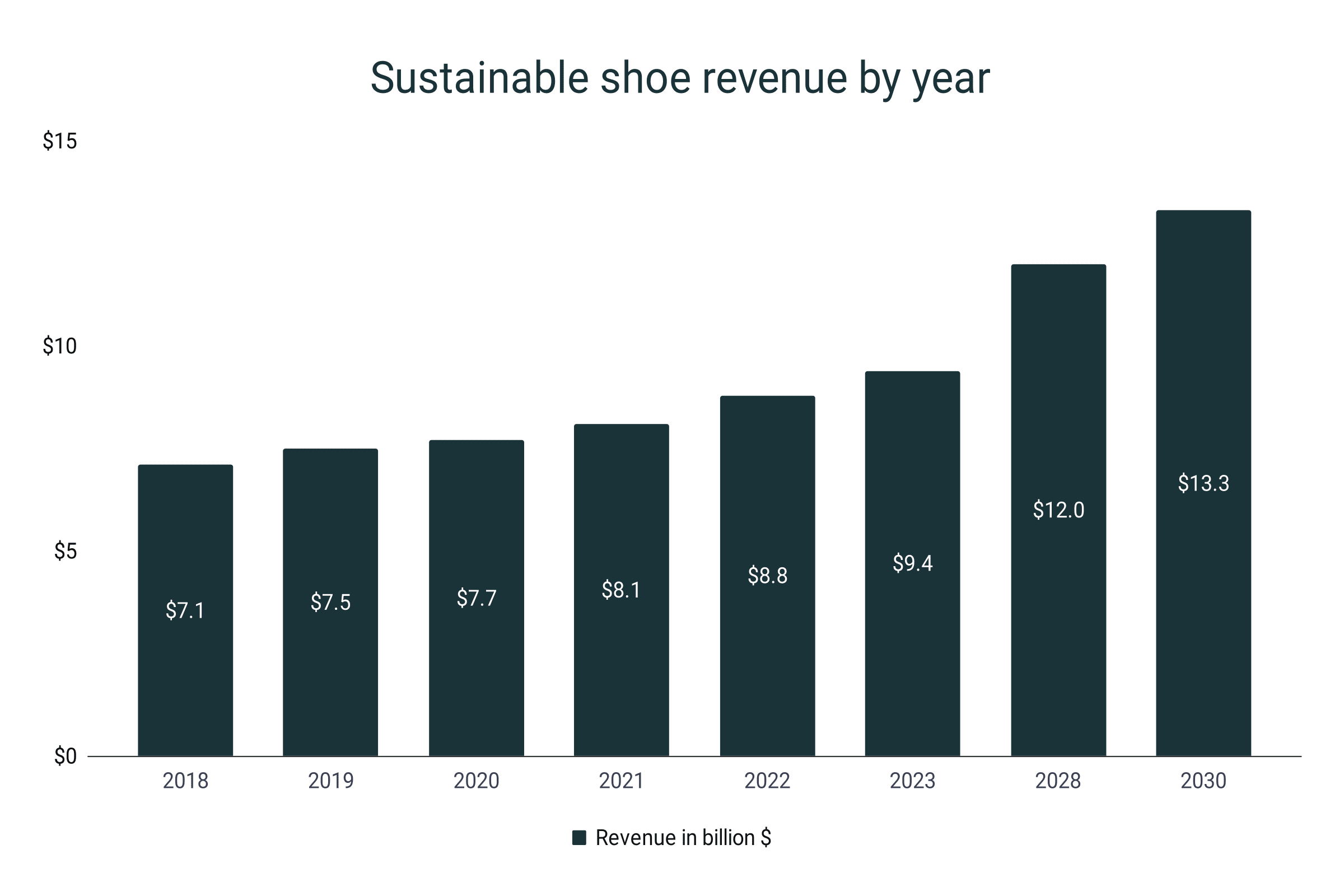
Sustainable shoe market by type
- In 2022, sports shoes tagged as sustainable generated $3.3 billion in revenues.
- 37.3% of all sustainable shoes produced in 2022 were comprised of athletic footwear models
- Meanwhile, the remaining 62.7% of all sustainable shoes are non-athletic.
- By 2030, the revenue from non-athletic sustainable shoes will reach $8.3 billion.
Sustainable shoes by type in 2022
|
Type |
Percent share |
|
Athletic shoes |
37.3% |
|
Non-Athletic shoes |
62.7% |
Sustainable shoe market by channel
- 40% of all sustainable shoes are bought through specialty stores.
- Supermarket is the second biggest channel contributing 24.7% of all sustainable footwear sold.
- Meanwhile, online-bought sustainable shoes accounted for 15%.
- The remaining 20.3% is attributed to other channels including local stores and outlets.
Sustainable shoe market by channel
|
Channel |
Percent share |
|
Specialty store |
40% |
|
Supermarket |
24.7% |
|
Online |
15% |
|
Others |
20.3% |
Sustainable shoe market by category
- Meanwhile, 53.4% of sustainable footwear manufactured annually are men’s shoes.
- Meaning, by the end of 2023, men’s sustainable footwear segment will be valued at around $5 billion.
- 38.2% of all sustainable shoes are women’s shoes while 8.4% are for kids.
Sustainable shoes by category
|
Category |
Percent share |
|
Men |
53.4% |
|
Women |
38.2% |
|
Kids |
8.4% |
Sustainable shoe market by age
- Gen Zs were found to be most willing to consume sustainable footwear products. About 73% of those born from 1995-2012 expressed willingness.
- 68% of millennials, people born from 1980-1994, are inclined to buy sustainable shoes.
- On the other hand, 55% of Gen X (1965-1979) while 50% of the Silent Gen (1925-1945) are keen on purchasing shoes tagged as sustainable.
- Baby Boomers (1946-1964) are the least enthusiastic about buying sustainable footwear. Only 42% expressed willingness to buy them.
The willingness of various generations to buy sustainable shoes
|
Generation |
Willingness |
|
Generation Z |
73% |
|
Millennials |
68% |
|
Generation X |
55% |
|
Baby Boomers |
42% |
|
Silent Generation |
50% |
Sustainable shoe production
- Approximately 330 million pairs of sustainable shoes are manufactured annually and is expected to grow in the coming years.
- Over 700 brands and retailers are members of the Footwear Distributors and Retailers of America (FEDRA), which is an organization that promotes a standard for Environmentally Preferred Materials (EMP) on shoes.
- Based on the EMP standards of FEDRA, a minimum of 20% recycled content should be observed in using synthetic leather.
- By 2035, the target is 80% recycled content in PU or synthetic leather.
- For leather, the current minimum is 20%.
- The standard would be at least 50% recycled leather content by 2035.
- For foam, as of 2023, only 5% recycled content is needed. The minimum will be raised to 25% by the end of 2035.
- FEDRA also targets to increase the recycled content in shoe packaging from 50% in 2023 to 90% by 2035.
- In cartons, the 75% minimum recycled content will be raised to 85% in 2035.
- In 2023, Saucony released its Triumph RFG which is composed of a midsole that is 55% corn-based and an outsole that is 80% natural rubber.
Environmentally Preferred Materials (EMP) used in footwear production
|
Material |
Current Minimum Recycled Content (2023) |
Target Minimum Recycled Content (2035) |
|
Synthetic Leather (PU) |
20% |
80% |
|
Leather |
20% |
50% |
|
Man-made fibers (Polyester, Nylon, Spandex, etc.) |
50% |
100% |
|
Natural fibers (cotton, hemp, jute, linen) |
50% |
80% |
|
Natural Wool |
50% |
80% |
|
Natural Rubber |
20% |
50% |
|
Foam |
5% |
25% |
|
EVA |
20% |
50% |
|
Thermoplastic (BPU, TPU, PP, TPR, Synthetic Rubber) |
20% |
50% |
|
Packaging (Paper and plastic) |
50% |
90% |
|
Carton (Corrugated/Shoebox) |
75% |
85% |
|
Metal |
15% |
50% |
Sustainable shoe consumption trends
- 23% of shoe consumers in the US say that the sustainable aspect of shoes is extremely important.
- On the other hand, 15% say sustainability on footwear is not an important consideration when buying shoes.
- 64% of consumers say they are willing to pay more when buying sustainable shoes.
- Meanwhile, 36% are not keen on paying additional.
- 35% say they are fine with paying $1-5 extra for sustainable footwear products.
- About 16% are willing to pay $6-10.
- Additionally, 13% of Americans are willing to pay $10 or more when buying sustainable shoes.
Willingness to pay extra for sustainable shoes
|
Additional cost |
Willingness |
|
0 |
36% |
|
$1-5 |
35% |
|
$6-10 |
16% |
|
$10+ |
13% |
